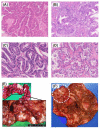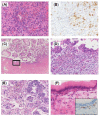Ovarian cancer stroma: pathophysiology and the roles in cancer development
- PMID: 24213462
- PMCID: PMC3712711
- DOI: 10.3390/cancers4030701
Ovarian cancer stroma: pathophysiology and the roles in cancer development
Abstract
Ovarian cancer represents one of the cancers with the worst prognostic in adult women. More than half of the patients who present with clinical signs such as abdominal bloating and a feeling of fullness already show advanced stages. The majority of ovarian cancers grow as cystic masses, and cancer cells easily spread into the pelvic cavity once the cysts rupture or leak. When the ovarian cancer cells disseminate into the peritoneal cavity, metastatic nests may grow in the cul-de-sac, and in more advanced stages, the peritoneal surfaces of the upper abdomen become the next largest soil for cancer progression. Ascites is also produced frequently in ovarian cancers, which facilitates distant metastasis. Clinicopathologic, epidemiologic and molecular studies on ovarian cancers have improved our understanding and therapeutic approaches, but still further efforts are required to reduce the risks in the patients who are predisposed to this lethal disease and the mortality of the patients in advanced stages. Among various molecules involved in ovarian carcinogenesis, special genes such as TP53, BRCA1 and BRCA2 have been well investigated. These genes are widely accepted as the predisposing factors that trigger malignant transformation of the epithelial cells of the ovary. In addition, adnexal inflammatory conditions such as chronic salpingitis and ovarian endometriosis have been great research interests in the context of carcinogenic background of ovarian cancers. In this review, I discuss the roles of stromal cells and inflammatory factors in the carcinogenesis and progression of ovarian cancers.
Figures



Similar articles
-
[Ultrasonography in acute pelvic pain].Acta Med Croatica. 2002;56(4-5):171-80. Acta Med Croatica. 2002. PMID: 12768897 Review. Croatian.
-
Ovarian epithelial-stromal interactions: role of interleukins 1 and 6.Obstet Gynecol Int. 2011;2011:358493. doi: 10.1155/2011/358493. Epub 2011 Jun 26. Obstet Gynecol Int. 2011. PMID: 21765834 Free PMC article.
-
Peritoneal carcinoma in women with genetic susceptibility: implications for Jewish populations.Fam Cancer. 2004;3(3-4):265-81. doi: 10.1007/s10689-004-9554-y. Fam Cancer. 2004. PMID: 15516851 Review.
-
Prophylactic Oophorectomy: Reducing the U.S. Death Rate from Epithelial Ovarian Cancer. A Continuing Debate.Oncologist. 1996;1(5):326-330. Oncologist. 1996. PMID: 10388011
-
Advances in the management of epithelial ovarian cancer.J Reprod Med. 2005 Jun;50(6):426-38. J Reprod Med. 2005. PMID: 16050567 Review.
Cited by
-
METTL3-mediated maturation of miR-126-5p promotes ovarian cancer progression via PTEN-mediated PI3K/Akt/mTOR pathway.Cancer Gene Ther. 2021 Apr;28(3-4):335-349. doi: 10.1038/s41417-020-00222-3. Epub 2020 Sep 16. Cancer Gene Ther. 2021. PMID: 32939058
-
Prognostic Factors After the First Recurrence of Ovarian Cancer.J Clin Med. 2025 Jan 13;14(2):470. doi: 10.3390/jcm14020470. J Clin Med. 2025. PMID: 39860476 Free PMC article.
-
The Development of a Three-Dimensional Platform for Patient-Derived Ovarian Cancer Tissue Models: A Systematic Literature Review.Cancers (Basel). 2022 Nov 16;14(22):5628. doi: 10.3390/cancers14225628. Cancers (Basel). 2022. PMID: 36428724 Free PMC article. Review.
-
An evolving story of the metastatic voyage of ovarian cancer cells: cellular and molecular orchestration of the adipose-rich metastatic microenvironment.Oncogene. 2019 Apr;38(16):2885-2898. doi: 10.1038/s41388-018-0637-x. Epub 2018 Dec 19. Oncogene. 2019. PMID: 30568223 Free PMC article. Review.
-
Comparison of the enzymatic efficiency of Liberase TM and tumor dissociation enzyme: effect on the viability of cells digested from fresh and cryopreserved human ovarian cortex.Reprod Biol Endocrinol. 2018 Jun 2;16(1):57. doi: 10.1186/s12958-018-0374-6. Reprod Biol Endocrinol. 2018. PMID: 29859539 Free PMC article.
References
-
- Berkenblit A., Cannistra S.A. Advances in the management of epithelial ovarian cancer. J. Reprod. Med. 2005;50:426–438. - PubMed
LinkOut - more resources
Full Text Sources
Molecular Biology Databases
Research Materials
Miscellaneous

